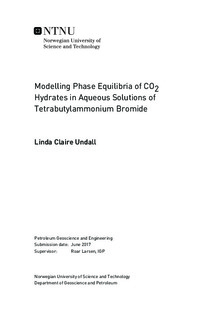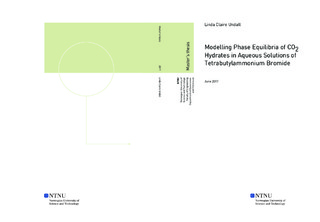| dc.description.abstract | The oil and gas industry s increased focus on efficiency in recent times, encourages development of new technologies. Technologies such as; hydrate based desalination, hydrate based gas capture, hydrate based gas transport and hydrate based gas storage, are proposed to have the potential to reduce costs and improve safety, compared to conventional alternatives. Hydrate phase equilibria models for hydrate promoters (additives that promote hydrate formation) are believed to be a useful tool for hydrate based technologies. There are few available hydrate promoter models known to us. Development of hydrate inhibitor models have had great success for their use, and it is believed that the development of hydrate promoter models may have the same.
A model for phase equilibria of CO2 hydrates in aqueous solutions of tetrabutylammonium bromide (TBAB) has been developed. TBAB is a hydrate promoter. Experimental CO2/ TBAB hydrate phase equilibria data and CSMGem simulation data for pure CO2, were the basis for modelling. The starting point was the hypothesis that CO2/ TBAB phase equilibria is a horizontal shift of CO2 phase equilibria. This resulted in the development of Model 1. Model 1 is implicit and inaccurate, meaning that a horizontal shift is not a valid approximation. Further modelling resulted in an explicit model, Model 2, which modelled a more complex shift by expressing the promotion temperature (DeltaT) as a function of temperature and TBAB concentration. The accuracy of Model 2 was satisfactory. With the development of Model 2 the aim of this master thesis had been reached. The developed models and experimental data show that maximum promotion effect occurs at 25 weight% TBAB, and not at the concentration corresponding to maximum cavity occupation (approximately 40 weight% TBAB).
Model 2, an explicit model for CO2/ TBAB hydrate phase equilibria, may be seen as a small step towards commercialization of hydrate based technologies. Development of phase equilibria models for other hydrate promoters, and later software, is strongly encouraged. | |

